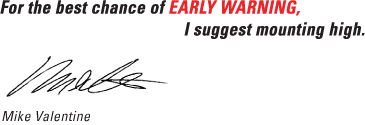Laser Detector Defense Techniques

There are TWO ways to look at optimizing laser detection
1. Certainty of detection in every encounter, even if that reduces the possibility of advance warning.
2. Maximization of advance warning, even if it reduces the certainty of detection in all encounters.
One must chose between these alternatives since they turn out to be mutually exclusive. A blend of both is possible if you accept that neither will be maximized.
In the real world, every laser encounter is different. The complicating factors are:
A. The amount of sunlight (direct, reflected, or scattered) in the detector’s field of view.
B. The color of the vehicle in which the detector is installed.
C. The distance from the laser gun.
D. The road geometry of the laser trap.
E. The traffic between the laser trap and the detector.
A. Sunlight interferes with laser reception.
You can regard sunlight as the equivalent to background noise while trying to listen for weak sounds. Laser gun photons and the near-infrared components of sunlight are indistinguishable. Detrimental sunlight can be directly shining into the laser detector (the worst), or reflected and scattered by the world at large. V1 has a specially tailored field of view to exclude “background glow” from areas that are unlikely to contain laser signals (way high, way low, or off to the side).
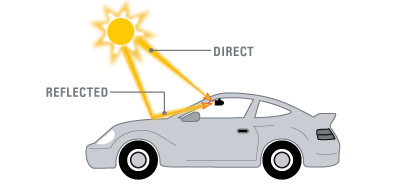 B. The color of the vehicle can influence the amount of sunlight relected from the hood into the detection optics. White, silver, and bright or metallic colors in general are 100 times more likely than gloss black to reflect competing light into the laser detector.
B. The color of the vehicle can influence the amount of sunlight relected from the hood into the detection optics. White, silver, and bright or metallic colors in general are 100 times more likely than gloss black to reflect competing light into the laser detector.
C. The pencil-thin beam of the laser gun expands with distance. The actual beam is only several feet wide at 500 feet, but “aiming wobble” introduced by the human holding the bulky gun make the detectable beam at least three times larger. Even without the wobble, it covers most of the roadway after a mile. This means it is actually much easier to find a fragment of the beam at greater distances from the laser trap. At short ranges, the beam may be so concentrated that a detector mounted away from the aim point on the vehicle may not be able to pick up enough stray energy to activate an alarm.

D. Curves and hills decrease chances of warning. The laser detector needs a fragment of the direct laser beam, or at least a low angle reflection or glint of it. The beam is a straight line. If, for example, the laser is measuring cars in a curve, the beam cuts across the curve, touching it only briefly. If the curve is even moderately tight, all laser energy that misses the target will soon be off the roadway and therefore out of play for the detector in any other car. While that setup may sound ideal as an enforcers’ strategy, it also increases the probability of phony readings because of swiping error.
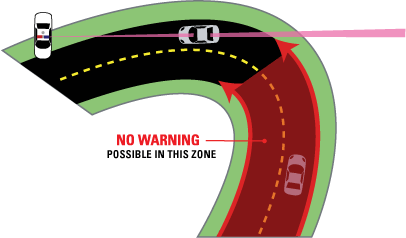
E. Traffic ahead may block (bad), or reflect (good), the laser energy from a distant laser trap. The chances of blockage are considerably greater than a lucky reflection. Light traffic is an advantage because there are other motorists ahead serving as bait for the laser. A shot at them is a chance for your detector to warn you. Heavy traffic, especially if dominated by trucks, is bad because there can be nearly 100% line-of-sight blockage until it’s your turn to be the target.
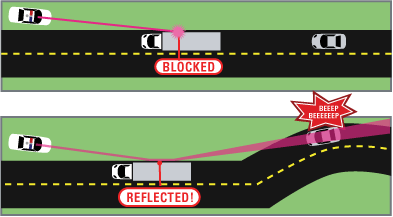
![]()
Now that we have The Facts, let’s put them into a DEFENSE SYSTEM.
![]()
If one’s objective is never to miss a laser encounter, I recommend mounting the laser detector as close to the typical laser aiming points as possible. Here in the US, most laser operators aim at the front license plate since it is usually made with a special reflective treatment to aid night-time visibility (works great for laser visibility too, day or night). If there’s no front plate (some states don’t require one), then a headlamp cluster or piece of bright grillwork is the next most promising aiming point.Advanced warnings (a warning in time to do some good) are more likely if one can avoid some problems caused by the low mounting position. Advance warnings require the greatest possibility of receiving a weak fragment of the beam while it is being used on traffic a good distance ahead. To maximize reception of weak signals, one must reduce blockage and interference.
Mounting high on the windshield will position the detector to “see” through the windows of most vehicles ahead. Glass in vehicles ahead is a good thing for your detector to see; it can scatter reflections in your direction. Sometimes it develops a glow, or a bloom, when the beam strikes, giving yet another chance for advanced warning.
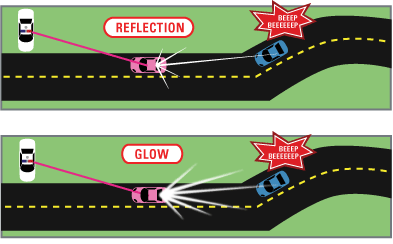
Mounting high on the windshield reduces the effect of sunlight reflected from the hood, which increases the detector’s ability to find weak beam fragments. Daytime warning sensitivity is completely dominated by how one manages the sunlight issues.
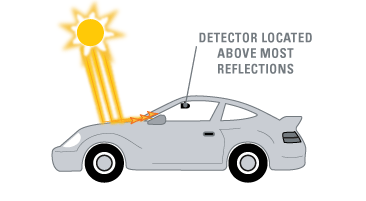
![]()
Mounting high behind the tint band may reduce the laser signal somewhat, but it reduces the sunlight contamination by the same amount. The result is an unchanged laser-to-sunlight ratio from the scene beyond your vehicle, but with reduced hood reflections owing to a higher vantage point—a net gain. Only in the dead of night would a just-below-the-tint-band mounting position be beneficial.
The downside of high mounting is the move away from the most common aiming points. This means that in bright sunlight, you may miss the occasional direct hit from very close range—no detection at all! But that’s possible with a low mounting as well, just not as often.
Now you know the variables, so you can make your own choice. To me, a warning too late is the same as no warning.
